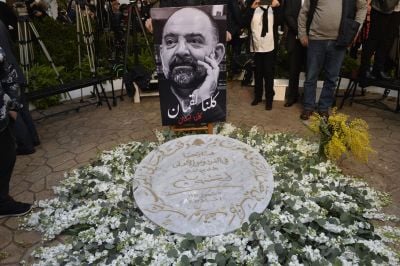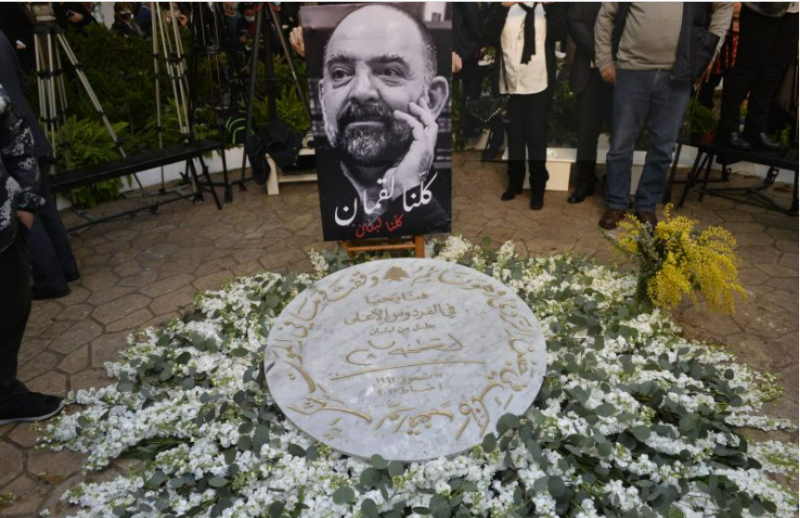
At the funeral of Lokman Slim, Feb. 11, 2021, in Haret Hreik, in the family home. (Credit: Nabil Ismail)
This investigation was published one year ago to mark the first anniversary of the assassination of Lokman Slim. L'Orient Today is republishing this article again, two years after the tragedy.
On Wednesday Feb. 3, 2021, around 10:30 p.m., in Tefahta, in South Lebanon, two young people from the area met up to spend the evening together.
On a side road leading to Addousieh, close to the Saida Highway, they spotted a black rental car, parked on the left side of the road. Intrigued, they slowed down to take a look.
Inside the vehicle, a man was lying face down in the front seats, one bare foot sticking out of the driver’s window. The two young men thought he was just yet another drunken driver sleeping by the road. They drove on.
It never occurred to them that it was no other than the erudite intellectual Lokman Slim, who had been shot six times — five times in the head and once in the shoulder — and then abandoned in his car, lying in his own blood, and whose death was to be announced the following morning.
By cross-checking information from security and judicial sources and other sources close to the victim, L’Orient-Le Jour was able to reconstruct the horrific day of the assassination of the eminent Shiite publisher, linguist, political activist and prominent opponent of Hezbollah.
To this end, we must first go back to Saturday, Jan. 30, 2021, four days before the murder.
During a lunch with friends close to Jezzine, in the South, Slim ran into Mohammad al-Amin, a writer, whom he had known for 30 years.
Amin invited Lokman to visit him in his new house in Niha. The two men agreed to get together for lunch along with Chbib al-Amin, a poet and Slim’s closest friend.
On Wednesday Feb. 3, the day of the invitation, Slim left his home in Haret Hreik toward the end of the morning and drove toward the south of the country in a car that he had rented, as he was in the habit of doing, allowing his wife to drive their common vehicle.
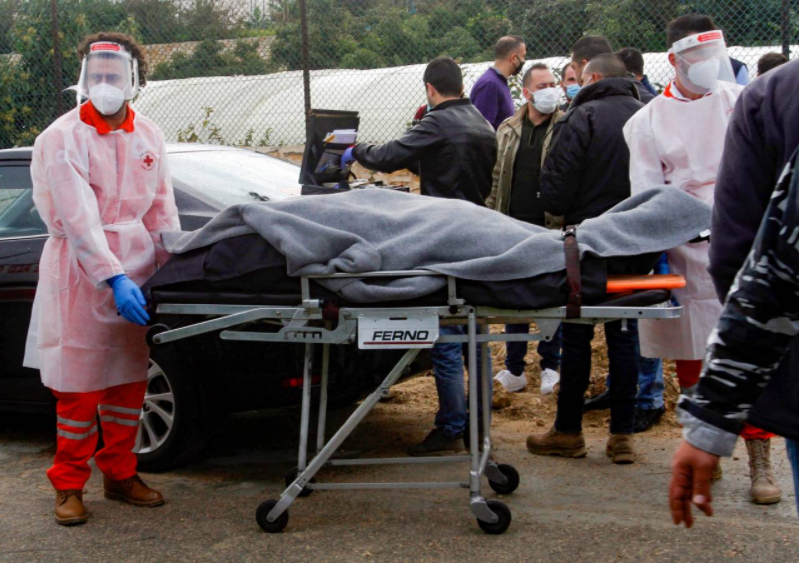 The body of Lokman Slim is evacuated on Feb. 4, 2021, shortly after his assassination in South Lebanon. (Credit: Mahmoud Zayyat /AFP archives)
The body of Lokman Slim is evacuated on Feb. 4, 2021, shortly after his assassination in South Lebanon. (Credit: Mahmoud Zayyat /AFP archives)
The first video surveillance images obtained by the investigators show Slim’s Toyota Corolla in Khaldeh around noon, followed by three and then by five vehicles.
The suspicious cars were all fitted with false plates and were sporadically spotted by other surveillance cameras on the Saida-Sur highway.
One vehicle followed Slim to his destination, to Mohammad al-Amin’s house, where he arrived around 1:30 p.m.
He did not suspect anything. The lunch with his two friends went smoothly. It was pleasant. Nothing disturbed their get together, not even upsetting phone calls.
Slim did not speak of any threats that day and seemed so serene and calm that he dozed off at 6 p.m., after a hearty meal.
When he woke up, he had a cup of tea and a warm chat with Mohammad al-Amin’s relative who, as usual, swung by unexpectedly. It was Slim’s first time meeting him.
Kidnapped some 400 meters from his friend’s house
At around 8 p.m., Slim decided it was time to return to Beirut.
He thanked his host, who gave him a box with the lunch’s leftovers. Outside, a storm was raging, so they said goodbye at the doorstep.
None of the people present at that pleasant meeting would witness the moment when Slim climbed into his car before being abducted two minutes later in an inhabited neighborhood within the United Nations Interim Force in Lebanon (UNIFIL) area of operation.
According to information obtained by L’Orient-Le Jour, Slim’s Toyota Corolla allegedly hit the road at 8:30 p.m. and was immediately followed by two of the suspected cars, which surrounded his vehicles 400 meters along the road, forcing him to stop.
Trapped, Slim was purportedly kidnapped and placed in one of his captors’ cars.
One of the attackers took the wheel of Slim’s Toyota, and the three vehicles headed toward the Saida-Sur highway, where they were seen several times.
They drove for 36 kilometers before taking a sideroad leading to Addousieh, where the crime was ostensibly committed, one kilometer away from the highway.
Meanwhile, at the Slim family house in Haret Hreik, in the southern suburbs of Beirut, concern was mounting. Slim hadn’t picked up his phone since he left his friend’s house.
His sister, Rasha al-Ameer, and wife, Monika Borgmann, began making frantic calls to Mohammad and Chbib al-Amin to try to locate him via his cell phone.
The device was finally found later that night on the side of the road where he was abducted in Niha.
Although the security services were informed of this disturbing disappearance, it was not until the next day at 7:40 a.m. that Slim’s body was found in his own car near Saida. He was 58 years old.
The autopsy report showed that he died of several hemorrhages caused by the six bullets received in the back of his head at less than one-meter range, shot with a 7.65 mm caliber gun.
It is highly likely that the victim was executed in his own car given the holes in the seats and the five shell casings that were found on the crime scene. The investigators, however, could not get their hands on the sixth shell casing.
Everything about the unfolding of the crime and the crime scene indicates that Slim’s killers did not encounter any obstacles in murdering him, nor did they find the need to clean up after themselves.
Inside the vehicle, the remains of the crime sat next the traces of a well-spent day with old friends: the box of food leftovers, a notebook to write down the inspirations of the moment, a book and groceries for the house.
Assassinated in Hezbollah stronghold
Founder of the Dar al-Jadeed publishing house, and the unique archive center on the contemporary history of Lebanon, Umam, as well as the Hayya Bina non-governmental organization, a documentary filmmaker committed to the issue of collective violence, a fervent defender of human rights and opponent of sectarianism, Slim’s reputation goes far beyond the borders of the land of the cedars.
The news of his assassination on Feb. 4, 2021, sparked an outcry in Lebanon and abroad.
The United States, France and the Arab League denounced this “barbaric act,” demanding that culprits be brought to justice.
Six months after the devastating Beirut port explosion, the specter of political assassination had resurfaced in Lebanon and the shadow of Hezbollah hung over it.
Slim hailed from a large Shiite family in Beirut’s southern suburbs, Hezbollah’s stronghold, where he had always lived and was a vocal critic of the Shiite party, never hiding his acquaintances with Western diplomats.
His political stances earned him threats and accusations from Hezbollah sympathizers of “treason,” and being a “collaborator” in the pay of Washington.
On Dec. 13, 2019, after he discovered death threats plastered on the walls of his home, he made a statement pinning all reasonability for any act that would target him or his family on Hezbollah leader Hassan Nasrallah and Parliament Speaker Nabih Berri, the head of the Amal Movement.
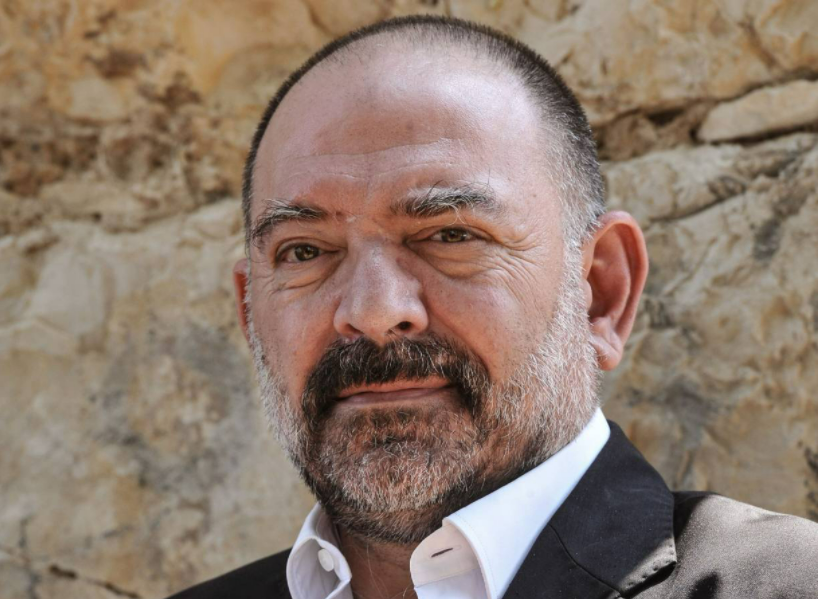 Lokman Slim. Photo provided to AFP by the family of Lokman Slim
Lokman Slim. Photo provided to AFP by the family of Lokman Slim
A year later, he was assassinated in an area affiliated with the two Shiite parties, which fuels suspicions about Hezbollah’s involvement in the crime.
After the news of the assassination, Nasrallah’s son, Jawad Nasrallah, was quick to tweet about it, posting a message that gave the impression that he rejoiced Slim’s death. He deleted the tweet shortly after.
Hezbollah condemned the crime, calling for identifying perpetrators.
However, responding to accusations hurled at his party, Nasrallah did not explicitly deny its involvement as he did following the Aug.4, 2020, port explosion.
“Any incident that happens in your area then you are accused until the opposite is proven? Is this something that is practiced in the whole wide world? Where else is this logic present?” Nasrallah said in a televised speech.
The importance of surveillance videos
A year after the assassination, no suspect has been arrested, and hopes are dwindling that the probe will never get to the bottom of what happened.
The body was found in the Zahrani district, and was automatically entrusted to the Public Prosecutor’s Office in Saida, under the instruction of Rahif Ramadan, the prosecutor of appeal of South Lebanon.
Ramadan ordered that the preliminary investigations take place at the hands of the local police that tracked down all traces and clues, seized all the documents and pieces of evidence found at the crime scene to analyze them and conducted the first interrogations in relation to the case.
It wasn’t until one week later that the magistrate then decided to entrust the investigation to the central intelligence office of the Internal Security Forces, known for their technical expertise.
Yet three months later, when the ISF submitted their report, the magistrate concluded that there was not enough evidence to identify a culprit or an accused. The case was then transferred to the first investigative judge of Saida for further investigation.
But what can be reasonably expected from an investigation carried out in an area under the control of Hezbollah and Amal?
A few days after the assassination, the Legal Agenda underlined the conflict of interest in the case, stressing that Ramadan is known for being close to the Parliament speaker.
The human rights NGO also expressed its concern that evidence might be concealed and that the investigation would be misled or emptied of all substance in a bid to hide the truth.
Contacted by L’Orient-Le Jour, Ramadan asserted that he was able to make a breakthrough in the case, but refused to comment on the fact that no person had been arrested.
The continuation of the investigation in the south was deemed as a disturbance to public order, prompting the judicial authorities to transfer the case to Beirut in June 2021.
It ended up landing on the desk of First Investigative Judge in Beirut Charbel Abu Samra.
The judge had his work cut out for him. Although the first investigation was carried out by the country’s main intelligence services, it was still full of holes .
The probe was put on hold for a few months due to strikes and summer holidays against the backdrop of the acute economic crisis, which paralyzed the course of legal cases.
The investigation, although secret, will resume imminently, Abu Samra is allegedly getting ready to order further inquiries, which would restart the investigation and allow the interrogations to take place.
However, a year after the horrific murder, the crime scene no longer exists, and several clues and evidence may have been lost to the new judge.
“It’s like a game of cards. If one or two cards are missing, you can’t do much with them,” a judicial source familiar with the case told L’Orient-Le Jour.
But all is not lost if the judge manages to get his hands on crucial and missing documents and pieces of evidence in the file the Public Prosecutor’s Office of Saida is required to provide, in the case that these are still in the office’s possession.
If Abu Samra was able to gain access to the video footage from the surveillance cameras posted all along Slim’s route on Feb. 3, 2021, he might achieve tangible results.
According to well-informed sources, the investigation, as it stands now, is incomplete in terms of geolocation. It does not mention anything about the movement of the kidnappers’ vehicles when the victim was leaving his home or during the hours he spent lunching at his friends’ house in Niha.
Where were the cars then? Could the suspects have stepped out of their cars?
The cameras positioned in front of certain commercial establishments could also help complete the puzzle, or even identify the attackers.
The accusers in the case are also counting on the cooperation of UNIFIL, whose nearest base, where 650 men from the French contingent are stationed, is located in Srifa, less than two kilometers from the abduction site.
Slim’s wife, Borgmann, appealed to the French authorities to help obtain footage from the UN force that could assist the investigation.
Both the French and the UN had the same reply: criminal cases are the local authorities’ responsibility.
Contacted by L’Orient-Le Jour, UNIFIL confirmed not having received requests from the judicial authorities and having not been kept abreast of the investigation into the assassination, adding that its surveillance system covers only the perimeter of its bases, implying that its cameras are not scattered in the surrounding villages.
‘This time it won’t pass’
The motives behind Slim’s assassination have been the subject of much speculation. After his death, a series of his statements that could have endangered his life were presented in a chronological order.
Among his remarks, one ought to mention his interview with the Saudi al-Hadath TV channel, one month before his assassination.
In the interview, Slim spoke of the Syrian government and Hezbollah’s involvement in the import of the ammonium nitrate that triggered the deadly 2020 Beirut explosion.
Did he know too much about this case? His death came shortly after the assassination of Joseph Bejjani, a photographer who was shot dead and whose phone was stolen on Dec. 21, 2020.
The investigation into the photographer’s murder had not been followed through. According to some media outlets, however, Bejjani, 37, had compromising photos in relation to the Beirut port explosion.
There’s another more controversial theory put forth by Mona Alami, a journalist, but this did not seem to interest the investigators.
Alami told L’Orient-Le Jour that she was never contacted in the framework of the investigation.
She established a link between Slim’s assassination and the fact that he had important information on Hezbollah’s shadow economy.
“He was looking for contacts in the new American administration to help a money launderer from the Shiite party who wanted to break away from Hezbollah,” she said.
Alami, who shared this information in the aftermath of the assassination, has since never expressed herself in the media.
“I didn’t keep quiet out of fear but because I had to face a smear campaign,” she said, assuring that she was not the only journalist with whom Slim had shared this information, which is proof, according to her, of his courage.
“He was not only seeking to fight the Shiite party with words but also with actions,” Alami added.
Slim’s family, however, does not wish to come forward in relation to this issue. Their main fight is to bring the killers to justice.
“Of course, I have an idea of who killed him, but it’s not enough for me to name them. I need proof. I want a real trial. I want justice,” Borgmann told L’Orient-Le Jour.
“I knew Lokman for 2o years. The fight against impunity was at the center of everything we did. Now, we have to [fight] without him but for him,” she added.
“‘Who do you want to file a complaint against?’ I was asked during the interrogation,” Rasha al-Ameer, Slim’s sister, said.
“I gave the letter in which my brother mentioned their names after the death threats he received. I told them, ‘Here, I don’t have the courage to say their names,’’’ Ameer told L’Orient-Le Jour.
Haunted by the stalemate of the port explosion investigation and the political relentlessness against its lead investigator Tarek Bitar, Slim’s family is pushing for an independent international investigation.
The international community has sent strong signals to the Lebanese authorities to contribute to the investigation.
The UN rapporteurs, for their part, could intervene in a more concrete manner should the probe remain at a standstill.
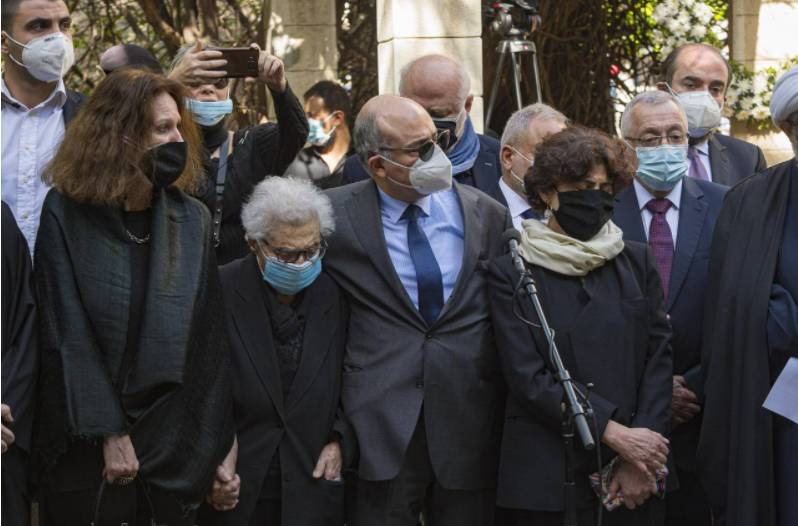 During Lokman Slim's funeral at the family home on Feb. 11, 2021 in Haret Hreik, in the southern suburbs of Beirut. (Credit: Nabil Ismail)
During Lokman Slim's funeral at the family home on Feb. 11, 2021 in Haret Hreik, in the southern suburbs of Beirut. (Credit: Nabil Ismail)
“This time it won’t pass like that,” Borgmann said determinedly, referring to the more than 200 political assassinations that have marked the history of the country, most of which have gone unpunished.
For the victims’ families, as for the entire population, the judiciary’s powerlessness appears to be inevitable.
“Expecting a thorough inquiry, or accepting even just a small investigation, is assuming Hezbollah does not exist in Lebanon,” said Ronnie Chatah, a journalist and the son of former Finance Minister Mohammad Chatah, who was killed in car bomb attack in 2013.
“There is no general appetite to confront Iran and Syria’s security needs in Lebanon. The Lebanese voices that used to champion that issue have all been killed by the same group,” he added.
“Of course, I know who pulled the trigger to kill Samir and I know who they were working for. Is this enough? No. What is needed is for these people to be punished and in prison. But can you bring a regime to justice? We will eventually, when things are calmer, when ‘they’ begin to lose,” said Gisele Khoury, the wife of Samir Kassir, a prominent historian and journalist, and a fervent critic of the Damascus regime, who was killed in a car bomb in 2005.
More than 50 years ago, a man understood the importance of condemning the political mastermind rather than the person who pulls the trigger.
This man was MP Mohsen Slim, Lokman Slim’s father, and the lawyer of the family of journalist Kamel Mroueh, one of the first intellectuals killed in 1966 in Lebanon.
Mohsen succeeded in putting the assassin of the founder of Al-Hayat newspaper and The Daily Star behind bars. It was suspected that the masterminds behind the crime were close to Nasser’s Egyptian regime. Those, of course, had nothing to worry about.
This article was originally published in French in L'Orient-Le Jour. Translation by Sahar Ghoussoub.
EDITOR'S NOTE: Due to contradictory information from sources, we have removed one sentence from this article.
